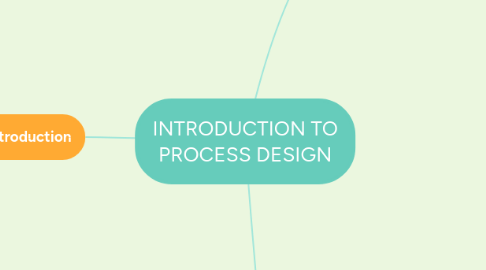
1. Introduction
1.1. Process designers create potential processes to convert raw materials in specified states into a desired product(s) in a specified state(s).
1.2. Information gathering
1.2.1. Process design problems are formulated problem statements
1.2.2. Searching the literature, especially the Internet for details about the chemical product
1.2.3. Need to know why the product is important
1.2.3.1. uses
1.2.3.2. characteristic properties
1.2.3.3. competitors
1.2.4. Information is available from the product design team
1.2.4.1. gain knowledge of the raw-material alternatives, principal chemical reactions, byproducts and intermediates
1.2.4.1.1. begin to target a range of potential production levels and possible plant locations
1.2.5. EXAMPLE 2.1 Vinyl Chloride Manufacture
1.2.5.1. Commodity chemicals that are produced continuously
1.2.5.2. Extremely toxic substance
1.2.5.2.1. Industrial plants must be designed carefully to satisfy government health and safety regulations
1.2.5.3. A new demand of vinyl chloride in Gulf Coast, US, a design team has been formulated
1.2.5.4. Considering 4 alternatives
1.2.5.5. Sufficient to consider only the production of the monomer
1.2.5.6. Thermophysical property data are available in extensive databases, can be estimated when not available
1.3. Environmental and Safety Data
1.3.1. In toxicology laboratories operated by chemical companies and governmental agencies, such as the Environmental Protection Agency (EPA) and Food and Drug Administration (FDA)
1.3.2. Tests are run to check the effects of various chemicals on laboratory animals
1.3.3. Chemicals are administered over differing periods, in varying - dosages - concentrations - stimulating effects
1.3.4. Source
1.3.4.1. Information on chemicals that are toxic to humans - Toxic Chemical Release Inventory (TRI)
1.3.4.2. National Fire Protection Association (NFPA)
1.3.5. Hazard to Health, Flammability Hazard
1.4. Chemical Prices
1.4.1. Often related to supply and demand
1.4.2. Difficult to estimate
1.4.3. Economic analyses are conducted using a range of chemical prices to determine the sensitivity of the results to specific prices
1.4.4. Source
1.4.4.1. ICIS Chemical Business
1.4.5. Manufacturers of the chemicals should be contacted directly to obtain better estimates
1.4.6. In some cases, it may be desirable to estimate the prices of utilities during process creation
2. Experiments
2.1. Design concepts are the result of extensive experiments in the laboratory, which provide valuable data for the design team
2.2. Common to request additional experiments at other conditions of compositions, temperatures, and pressures, and using solvents that are more representative of large-scale production
2.3. Necessary to aid in the selection and preliminary design of separation operations
2.3.1. gas mixtures
2.3.1.1. adsorption - adsorbent
2.3.1.2. absorption - absorbent
2.3.1.3. gas permeation - membrane material
2.3.2. nonideal liquid mixtures
2.3.2.1. distillation experiments should be conducted early because the possibility of azeotrope formation can complicate the selection of adequate separation equipment
2.3.2.1.1. testing of one or more solvents or entrainers
2.3.3. solids
2.3.3.1. early lab tests of such operations as crystallization, filtration, and drying
2.4. Data obtained from laboratory are tabulated and usually regressed
2.4.1. to allow addition to the preliminary database used by the design team in preliminary process synthesis
3. Preliminary Process Synthesis
3.1. Process synthesis - the assembly of processing operations into a process flowsheet
3.2. Challenge - synthesis of configurations that produce chemicals in a reliable, safe, and economical manner, at high yield and with minimal waste.
3.3. Chemical State
3.3.1. Value
3.3.1.1. Mass
3.3.1.2. Composition
3.3.1.3. Phase
3.3.1.4. Form, if solid phase
3.3.1.5. Temperature
3.3.1.6. Pressure
3.3.2. Care must be taken to design a process that is sufficiently flexible to meet changing demands
3.3.3. Scale of the process is determined on the basis of the projected demand for the product
3.3.4. 6 conditions listed above are usually sufficient to fix the state of a substance
3.4. Process Operations
3.4.1. Chemical reaction
3.4.1.1. involves considerations: degree of conversion, reaction rates, competing side reactions, and the existence of reactions in the reverse direction
3.4.2. Separation of chemical mixtures
3.4.2.1. inserted when the raw materials contain impurities that need to be removed before further processing
3.4.2.2. depends first on the phase of the mixture and second on the differences in the physical properties of the chemical
3.4.2.3. Operation
3.4.2.3.1. vapor–liquid separation: differences in volatilities are large
3.4.2.3.2. solid–liquid separations: melting points differ significantly
3.4.2.3.3. liquid–liquid separation: differences in volatilities and melting points are small
3.4.2.3.4. adsorption and membrane separation: differences in absorbability, adsorbability or permeability
3.4.3. Phase separation
3.4.3.1. using temperature- and/or pressure-reduction operations, such as heat exchangers and valves
3.4.4. Change of temperature
3.4.4.1. Often a process stream needs to be heated or cooled from its source temperature to its target temperature
3.4.4.2. accomplished through heat exchange with other process streams that have complementary cooling and heating demands
3.4.5. Change of pressure
3.4.5.1. often ignored in the early stages of process design
3.4.5.2. common to disregard the pressure drops in pipelines when they are small relative to the pressure level of the process equipment
3.4.5.3. estimation of pressure drops gains importance because flow rates are controlled by adjusting the pressure drop across a valve.
3.4.6. Mixing and splitting of streams or batches
3.4.6.1. to combine two or more streams to achieve a product specification.
3.4.7. Operations on solids, such as size reduction and enlargement
